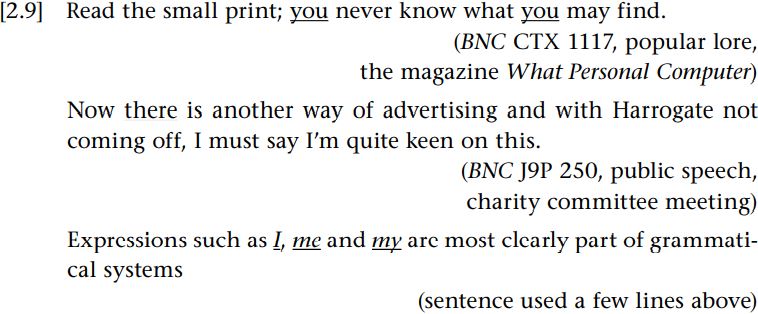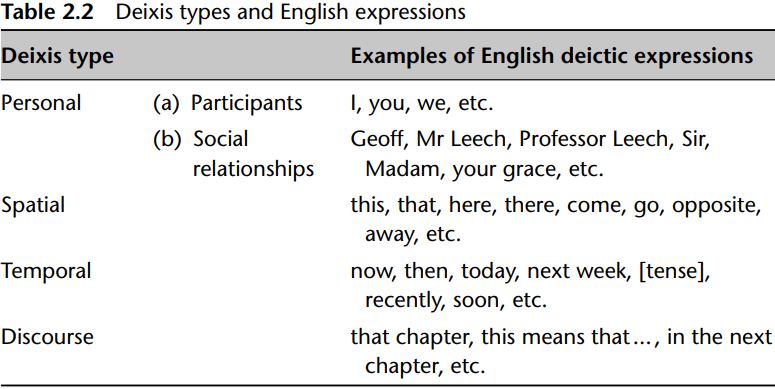
Deixis
 المؤلف:
Jonathan Culpeper and Michael Haugh
المؤلف:
Jonathan Culpeper and Michael Haugh
 المصدر:
Pragmatics and the English Language
المصدر:
Pragmatics and the English Language
 الجزء والصفحة:
21-2
الجزء والصفحة:
21-2
 23-4-2022
23-4-2022
 2165
2165
Deixis
We now turn to deixis, the category at the bottom of Table 2.1; we will discuss anaphora in the section following this one. Deixis relies heavily, though not completely, on the extralinguistic context to supply the referent, and not semantic elements within the deictic expression itself. It may be helpful to note here that the word deictic is borrowed from the Greek δεικτικ-ός ( deiktikos), meaning “able to show, showing directly”. Deixis involves connections between a reference point and aspects of the situation in which the utterance takes place; deictic expressions invite participants to work out particular connections. When somebody telephones another and says it’s me, they invite the interlocutor to work out, on the basis of oral characteristics, that me refers to the speaker. Occasionally, of course, the speaker’s assumptions that the interlocutor can work out who is speaking turn out to be wrong, and the interlocutor has to ask explicitly who it is (something which is potentially embarrassing, because the speaker assumed that you were sufficiently familiar with them to identify them). Consider another example, this time provided by Charles Fillmore (1997: 60):

Who is me? Where is here? When is tomorrow? And how big is this? Examples such as this neatly illustrate how one’s understanding depends on making connections between a reference point – that is, a deictic centre or anchorage point – from which the speaker positions their discourse and a particular context. If we cannot make these connections, we end up with very limited understanding.
The deictic centre is generally the I-here-now of the speaker, or, more accurately, of the speaking voice in the particular situation. The speaking voice could be that of, for example, an individual, a group of people, or a character in a book. Deictic expressions signal a perspective relative to a particular deictic centre (e.g. your “you” is my “I”; your “here” is my “there” etc.). In conversation, the deictic centre obviously fl ips back and forth according to who is speaking. The deictic centre can also be projected. If somebody rings you up and invites you over for some coffee, you may reply: I’ll come over in a few minutes. Come is a deictic verb, as it suggests the movement of something in the context towards the deictic centre. In this case, the deictic centre is not that of the speaker but that of the addressee. This is a case of deictic projection: the speaker projects the deictic centre onto the addressee and speaks from the point of view of the addressee.
A key point about deictic expressions is that they interface with grammatical systems. This feature is brought out in Levinson’s (1983: 54) definition of deixis:
Deixis concerns the ways in which languages encode or grammaticalise features of the context of utterance or speech event, and thus also concerns ways in which the interpretation of utterances depends on the analysis of that context of utterance.
Expressions such as I, me and my are most clearly part of grammatical systems (we shall see in a moment how the context of utterance has not always been grammaticalised in the same way in earlier periods of English). Table 2.2 displays the types of deixis traditionally identified and their associated expressions.
Of course, deictic expressions can be used non-deictically. Consider the underlined items in these sentences:

Here, you is a generic usage, not referring to anyone in particular (it is similar to “one never knows”); there does not pick out a particular location, but is a case of “existential there”, that is to say, a kind of dummy subject which occurs in clauses about the existence or occurrence of something; finally, I, me and my do not refer to the speaker, as they are (metalinguistic) mentions of the pronoun rather than uses of them. As Fillmore (1997) points out, even demonstratives, a category that seems to be the purest category of deictic items, in fact have both deictic and non-deictic usages. Gestural usages, such as this foot, are supported by a gesture like pointing; they are deictic.

Symbolic usages, in contrast, rely on general spatio-temporal knowledge; they could be accompanied by a gesture, but would still be understood without. For example, in this newspaper headline Technology: Let’s make this country the best (The Guardian, 1/9/13), it will be obvious to most UK-based Guardian readers that this country refers to the UK, without gestures. The converse is also true: typically non-deictic expressions can be used deictically. For example, he or she would not normally be discussed as deictic expressions, as they are typically anaphoric, referring back to something mentioned previously in the discourse rather than connecting with the extralinguistic context (we will discuss anaphora in the following section). But it is not too difficult to imagine a context in which they clearly have a deictic referring function. Consider a (reconstructed) conversation during which a parent brings a crying baby into the room and an interlocutor says:

We should also keep in mind the fact that items within categories, such as those of Table 2.1, vary with respect to the degree to which they are semantically descriptive and contextually pragmatic. For example, here indicates the speaker’s spatial deictic centre, but come also encodes the meaning of locomotion towards it.
Let us elaborate on the particular categories of Table 2.2. Personal, as a deictic category, refers to the identification of three discourse roles in the speaking situation: the speaker (the first person), the hearer (the second person), and the party being talked about (the third person). Person is a hugely important grammatical category. First, second and/or third person is marked or implicit in all utterances. An indication of its importance in English is in the fact that the second most frequent word in spoken English is I and the third is you (Leech et al. 2001: 144) (as we noted earlier, the most frequent is the). Personal deixis invites participants to identify the relevant discourse role(s) in the context.
Person markers are not devoid of encoded meaning. In fact, they rarely encode person alone, but also have other grammatical distinctions. In English, these are number (e.g. I vs. we), gender (e.g. he vs. she) and case (e.g. she vs. her). Note here that deictic person markers are typically the first and second persons, not the third. Third person forms are generally anaphoric, that is, not extralinguistic but referring back to the linguistic co-text of the utterance, though, as illustrated in the previous paragraph, third person forms can be used deictically.
 الاكثر قراءة في pragmatics
الاكثر قراءة في pragmatics
 اخر الاخبار
اخر الاخبار
اخبار العتبة العباسية المقدسة


